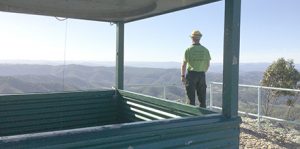The $1bn privatisation of NSW forestry assets has been placed in jeopardy by the bushfires, with large swaths of the land already burned out and the plan unlikely to proceed if the damage is too extensive. Source: Timberbiz
A scoping study announced in August is expected to continue to investigate whether a long-term lease of the plantations is in the best interests of the state but will now have to account for the impact of the fires.
Detailed assessments are still being conducted on the extent of the damage, but officials say approximately 47,000ha of state and privately owned softwood plantations have been impacted, based on preliminary assessments.
This amounts to about one-fifth of total softwood plantations, a spokesperson for the Forestry Corporation of NSW said. The corporation oversees 230,000ha of plantations in the central west, south and north of NSW, where fires still burn.
Current damage estimates are preliminary and possibly conservative, with ongoing fires preventing more detailed assessments being made.
Forestry corporation estimates about 32,000 hectares or 30% of forestry pine plantation around Tumut has been burnt in recent days.
Timber NSW general manager Maree McCaskill said she would expect the proposal would be placed on hold until the NSW Government can assess the impact and damage from the fires.
Visy told Daily Timber News that the recent fires in the Tumut region have directly affected its employees and the operations at its Tumut paper mill. The temporary shutdown of the plant during critical days of the fire was necessary for a short period and an orderly start-up of the mills has been completed.
Visy’s Tumut team is working through the logistics and impacts of the fires whilst remaining vigilant to the ongoing threat of flare ups and conditions. Once the current fire crisis passes, the company will undertake a thorough assessment.
Although the figure could climb as fires continue to burn and more assessments are undertaken, Regional Manager for the Snowy Region for Forestry Corporation of NSW Dean Anderson said many impacted trees may still be salvaged for processing.
“It is too early to say what the full impact is at this early stage because we will be able to salvage and use a lot of the burnt timber,” Mr Anderson said.
While a large area had been affected, in the short-term there was still a lot of work to do over the next year or so to salvage and process timber from affected areas.
“Forestry is a long-term industry and we will be replanting and re-growing these plantations, so they continue producing renewable, sustainable timber products for the future,” he said.
He said when pine plantations are burnt, the trees will die, but the timber may still be salvaged within the first six to twelve months following a fire.
“Over the coming months, we will be working closely with local contractors and mills to harvest and process timber salvaged from burnt areas,” Mr Anderson said.
According to its website, the Forestry Corporation of NSW is the largest grower of plantation pine in the country and produces enough timber to construct one-quarter of all houses built each year across Australia.








